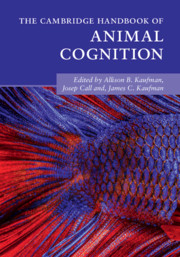Book contents
- The Cambridge Handbook of Animal Cognition
- The Cambridge Handbook of Animal Cognition
- Copyright page
- Dedication
- Contents
- Figures, Tables, and Boxes
- Contributors
- Acknowledgments
- Introduction
- Part I Communication and Language
- Part II Memory and Recall
- Part III Social Cognition
- Part IV Social Learning and Teaching
- Part V Numerical and Quantitative Abilities
- Part VI Innovation and Problem-Solving
- 28 Innovation and Problem-Solving Overview
- 29 General Intelligence (g) in Mice
- 30 Bowerbird Innovation and Problem-Solving
- 31 Parrot Innovation
- 32 Innovation in Marine Mammals
- 33 Innovation in Capuchin Monkeys
- 34 Innovation and Problem-Solving in Orangutans
- 35 Do Apes and Monkeys Know What They (Don’t) Know?
- 36 Decision Making in Animals
- Index
- References
35 - Do Apes and Monkeys Know What They (Don’t) Know?
The Question of Metacognition in Primates
from Part VI - Innovation and Problem-Solving
Published online by Cambridge University Press: 01 July 2021
- The Cambridge Handbook of Animal Cognition
- The Cambridge Handbook of Animal Cognition
- Copyright page
- Dedication
- Contents
- Figures, Tables, and Boxes
- Contributors
- Acknowledgments
- Introduction
- Part I Communication and Language
- Part II Memory and Recall
- Part III Social Cognition
- Part IV Social Learning and Teaching
- Part V Numerical and Quantitative Abilities
- Part VI Innovation and Problem-Solving
- 28 Innovation and Problem-Solving Overview
- 29 General Intelligence (g) in Mice
- 30 Bowerbird Innovation and Problem-Solving
- 31 Parrot Innovation
- 32 Innovation in Marine Mammals
- 33 Innovation in Capuchin Monkeys
- 34 Innovation and Problem-Solving in Orangutans
- 35 Do Apes and Monkeys Know What They (Don’t) Know?
- 36 Decision Making in Animals
- Index
- References
Summary
Over the past quarter of a century, scientists have attempted to answer the question of whether humans are unique in their self-reflective abilities, or whether versions of this might exist in nonhuman animals as well. This chapter explores the research on whether nonhuman primates (hereafter, primates) have the ability to monitor and control their own knowledge states, or metacognition. The chapter describes the two main paradigms that have traditionally been used to investigate this question, as well as their associated variations and limitations. This is followed by a summary of what has been found to date, with respect to metacognitive abilities across the primate order. The chapter concludes with a brief discussion of the questions that remain and areas for future investigation.
- Type
- Chapter
- Information
- The Cambridge Handbook of Animal Cognition , pp. 755 - 769Publisher: Cambridge University PressPrint publication year: 2021



